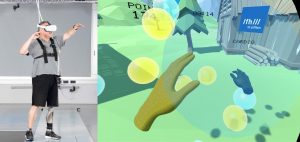Evaluating the Effects of an Immersive Virtual Reality-Based Balance Control Exergame on Healthy Individuals and Prosthetic Users – A Series of Pilot Studies
Aim and Research Question(s)
The aim of this master's thesis was to evaluate if the virtual reality exergame, developed at the FH St. Pölten, has the possibility to have an effect on the weight shift of healthy individuals and, in particular, the target group (individuals with a unilateral prosthetic leg). (1) Does the immersive, virtual reality exergame have an effect on the weight distribution in healthy individuals when setting a "weak side”? (2) What are the effects of immersive virtual reality-based balance training on postural control and gait behavior in individuals with a unilateral prosthetic leg? (3) How do individuals with a unilateral prosthetic leg rate the user experience, system usability, intrinsic motivation and simulator sickness when playing the VR exergame?
Background
Lower limb amputees (LLA) typically have functional restrictions, poor balancing confidence [1], and a lower level of trust in their prosthesis than in their healthy leg, which increases the risk of falling [2, 3]. Virtual reality offers a possibility to practice movement sequences again and again, individually adapted to improve motor learning, like with traditional therapy [1, 4].
Methods
Two study designs were conducted. In the first, the exergame was tested on 15 healthy participants to see if it had an effect on weight shift. In the second study design (AB- design, 2 weeks baseline 6 weeks intervention, two survey days per week) the exergame was evaluated with two participants with a lower limb prosthesis. As POs, gait analysis and three stanceanalyses using pressure plates were performed. In addition, active movement tests(BBS, DGI, TUG) were performed and questionnaires(UEQ, SUS, IMI, SSQ) were answered.
Results and Discussion
The exergame had a measurable effect on the weight shift of the healthy participants. In the single-subject research, both subjects discontinued the study due to covid infection. Subject 1 showed no immediate measurable effects of the virtual reality exergame in gait or stance analysis. The questionnaires showed a good acceptance of the VR system in motivation and user experience.
 Figure 1: Participant performing the VR Exergame
Figure 1: Participant performing the VR Exergame
Conclusion
In conclusion, the virtual reality exergame showed a clearly visible weight shift of the preset "weak side" of healthy individuals during the game. No clear evidence of the influence of exergame in stance and gait parameters in individuals with a unilateral leg prosthesis was found. Both participants were quite satisfied with the virtual reality game, the user experience was very positive and hardly any simulation sickness symptoms were triggered. However, participant 1 stated that he had already noticed a subjective improvement in everyday life in form of safer mobility.
References
[1] https://doi.org/10.1177/2050312113497942 [2] A.-K. Lindner, 2011. [3] https://doi.org/10.1089/g4h.2020.0028 [4] R. Riener and M. Harders, Virtual Reality in Medicine, English, 2012th edition. London: Springer, Apr. 2012, isbn: 978-1-4471-4010-8.
